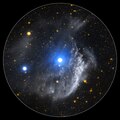| Emission nebula | |
|---|---|
| Planetary nebula | |
 | |
| Observation data: J2000 epoch | |
| Right ascension | 10h 24m 46.1s [1] |
| Declination | −18° 38′ 32.6″ [1] |
| Distance | 4800±500 [2] ly |
| Apparent magnitude (V) | 8.60 |
| Apparent dimensions (V) | 25″ |
| Constellation | Hydra |
| Designations | Ghost of Jupiter, Jupiter's Ghost, Eye Nebula, Caldwell 59 |
NGC 3242 (also known as the Ghost of Jupiter, Eye Nebula or Caldwell 59) is a planetary nebula located in the constellation Hydra.
Contents
William Herschel discovered the nebula on February 7, 1785, and catalogued it as H IV.27. John Herschel observed it from the Cape of Good Hope, South Africa, in the 1830s, and numbered it as h 3248, and included it in the 1864 General Catalogue as GC 2102; this became NGC 3242 in J. L. E. Dreyer's New General Catalogue of 1888.
This planetary nebula is most frequently called the Ghost of Jupiter , or Jupiter's Ghost due to its similar shape to the planet, but it is also sometimes referred to as the Eye Nebula. [3] The nebula measures around two light years long from end to end, and contains a central white dwarf with an apparent magnitude of 11. The inner layers of the nebula were formed some 1,500 years ago. [4] The two ends of the nebula are marked by FLIERs, lobes of fast moving gas often tinted red in false-color pictures. [5] NGC 3242 can easily be observed with amateur telescopes and appears bluish-green to most observers. Larger telescopes can distinguish the outer halo as well. [6]
At the center of NGC 3242 is an O-type star with a spectral type of O(H). [7]



